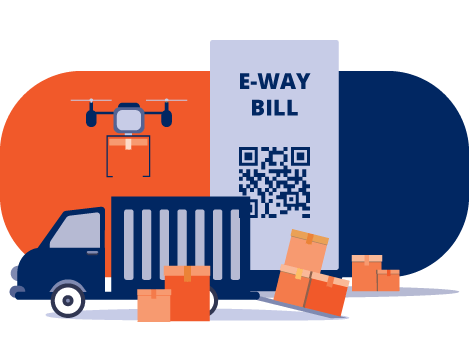What is an E-Way Bill? – A Complete Guide for Businesses

With the rapid evolution of the digital economy, complying with tax and transportation regulations is becoming a critical aspect of doing business. One of the most important compliance tools that was introduced under the Goods and Services Tax (GST) regime in India is the E-Way Bill. But what is it? Why do I need one? And how do I know if I am complying with E-Way Bill requirements?
This article will look to answer all your questions surrounding E-Way Bills: what they are and why businesses require them; how the E-Way Bill is generated; how to validate the E-Way Bill; and what the penalties are if it is not adhered to.
Understanding the basics – What is an E-way Bill?
Essentially an E-way Bill or Electronic Way Bill is the documentation required for the movement of goods from one point to another in India where the value of the goods is more than ₹50,000. This document is generated online on the E-Way Bill Portal (ewaybill.gov.in) and is generated for compliance under GST to track the movement of the goods while in transit.
The E-Way Bill is required for all movement of goods, both intra-state (within the same state) and inter-state (between states) and the E-way Bill can be generated by the supplier, recipient or transporter of the goods.
To summarize, the E-Way Bill scores documentation that the goods you are moving have complied with the requirements of GST law.
Why was E-way Bill introduced?
Before GST implementation, states were using their own rules to allow movement of goods without having to verify the source in terms of compliance as the states were not checking documentation before delivery on the ground. This resulted in a lack of accountability, delays, and compliance issues. Therefore, E-way bill system was introduced to:
- Create a system to track goods being sent from one place to another.
- Avoid tax avoidance through appropriate documentation so that proper tax is collected on all goods.
- Make compliance easier by combining all compliance into a single document, online platform.
- Reducing inefficiency in the supply chain; not to have needless barriers.
When is an E-way Bill Required?
E-way Bill will be generated for:
Any goods valued in excess of ₹50,000.
- For one invoice or bill (single delivery).
- Even though there may be multiple invoices which would amount to ₹50,000 or more in a single consignment.
Transportation is made:
• For sale.
• Transfer from one branch to another.
• Return of goods.
• Delivery of goods for job work.
On the ground the actual mode of transportation is by road, rail, air or ship.
Who should generate an E-way Bill?
Depending on the circumstances who is to generate an E-way Bill is:
Registered supplier – If you are sending the goods it is you who generates E-way Bill.
Registered recipient – If you are receiving the goods and the supplier is unregistered.
Transporter – If neither the supplier or recipient generates it the responsibility falls on the transporter.
E-Way Bill Creation:
This is a completely online process carried out through the E-Way Bill Portal.
Step-by-Step Instructions:
Login to the E-Way Bill Portal using your GST user name and password.
Select “Generate New” from the main dashboard.
Enter the details required and they are:
- Transaction type (inward or outward).
- Document type (invoice, bill of supply, challan).
- Document number and date.
- From and To addresses.
- HSN code and description of goods.
- Quantity and value.
- Transporter ID and vehicle number.
Once all details are entered you click submit, at which point the 12-digit E-Way Bill Number (EBN) is generated.
You can then print or share the E-Way Bill with your transporter.
E-Way Bill for Different Modes of Transport
- By Road – If you are transporting goods by road, the vehicle number is entered in the E-Way Bill.
- By Rail, Air or Sea – If you are transporting goods by rail, air or ship, the transporter ID and document number is entered instead of a vehicle number.
- Multi-vehicle movement – For goods transferred from one vehicle to another during transit, the E-Way Bill must be updated.
Penalties for Not Generating an E-Way Bill
Failing to generate an E-Way Bill can give rise to penalties and delaying your shipment.
- Financial penalty – ₹10,000 or the amount of tax that was evaded, whichever is higher.
- Seizing of goods – Authorities may seize your goods until they comply and produce documentation.
- Transport delays – Goods can be stopped if the transporter is undone until a valid E-Way Bill is generated.
E-Way Bill Under GST – Advantages
Transparency – Real time tracking of goods provides honesty in transactions.
Reduced Tax Evasion – All goods in transit are documented and no longer in an open jail.
Efficiency and Speed – No document retention or checkpoint delays.
Cost reduction – Less administrative burden for businesses.
Common Mistakes to Avoid When Generating an E-Way Bill
- Inserting the wrong vehicle number
- Using an expired E-Way Bill
- Not updating multi-vehicle transfer details
- Errors in HSN codes
- Forgetting to cancel the E-Way Bill if the shipment is not made.
Recent Developments on E-Way Bill System
The E-Way Bill system is developing constantly to ensure compliance becomes simpler. Some recent developments include:
- Integration with FASTag and RFID for live tracking of vehicles.
- Automatic calculation of distance between source and destination.
- Mobile app for faster E-Way Bill generation.
- Blocking of GSTIN if returns are not filed for 2 consecutive months
Conclusion
The E-Way Bill is an important police tool under GST for the movement of goods in India. It not only speeds up logistics, but it does so with transparency and accountability to the trade. Businesses owners and managers that understand and work the E-Way Bill process can avoid penalties, avoid delays and improve supply chain efficiency.
In summary, every time you move goods greater that ₹50,000, remember to E-Way Bill them from the official portal or mobile app. This small step will ensure that your business remains compliant with GST legislation and improve your transport operations.
Must Read:



